Michael Kane in Moorcock's Mars novels, and Matt Carse
in Brackett's
Sword of Rhianon also go back to the past of Mars.
But when they get there, Mars has seas, it's a live world far different
than the desert world we've come to expect. In contrast, Kline’s
time traveller seems to wind up on a Mars that's essentially the same as
Barsoom, and in roughly the same planetary epoch - i.e., deserts instead
of seas.
So, I tend to treat the whole ‘millions of years ago’ thing as a bit
of a red herring. One of the tricks we'll use to make Burroughs
and Kline match up is to examine our facts carefully. Things
that the hero sees and hears, his direct adventures and observations are
true. But things our hero knows because someone has thoughtfully
explained a bit of background to him, basically secondhand information
or unverified hearsay are not necessarily quite as true.
Where our hero or some other person jump to a conclusion, well, that's
not necessarily quite as true.


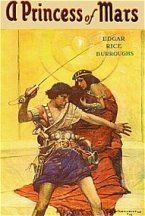
In fact, the unreliable narrative, or the unreliable narrator, has been
a staple of fiction for years. Noir is full of stories where the
protagonist turns out to be completely mistaken as a result of jumped conclusions
or bad information. In Swordsman of Mars, for example
Harry Thorne jumps to the wrong conclusions about Neva. In
the Moon Maid,
Julian jumps to all sorts of conclusions about how the dynamics of the
Moon work, but its clear that he's obviously guessing. John Carter's
words often depart from his actions, and in fact, Carter gets told a few
transparent whoppers by people, some of which he explodes and some of which
he doesn't.
So, as to whether Kline’s Mars is in the past or how far it's in the
past, we cannot be sure. Morgan never justifies or explains
how he knows this or how they determined a time period, and in many respects,
it seems irrelevant either to the plot or the flow of information and persons
between worlds. It is a statement which seems to have no practical
bearing on anything, when conceivably it should have (like time travel
being a one way trip, or the ‘interface’ with time being erratic, or the
flow rates differing... But Dr. Morgan never even peaks ahead into
Mars future, still millions of years in the past, to see what Boyd might
have been like as king of the planet in Swordsman of Mars.
At best, Kline was simply trying to get around the evolving picture
of Mars as a dead world, an idea that was becoming more and more ingrained.
In 1912 after all, when A
Princess of Mars came out, people pretty much took Percival Lowell
as mostly gospel. By 1930, there was increasing evidence that
Mars was colder, that its atmosphere was incredibly thin and lacked both
water and oxygen. Perhaps, adding a bit of wiggle room to avoid people
asking when Harry Thorne was going to meet John Carter. After
all, both books were set on Mars, and by the 1930s, Barsoom had become
'the' Mars. You actually had to do a bit of work.
It would be like doing a Jungle Book in Africa, Tarzan would loom
in the back of the reader's mind, no matter what, which may explain why
Kline’s Jan is set in South America.
So, given that it's unverified secondhand hearsay, I'm inclined to disregard
it, or at least bring a little flexibility to the subject.
We don't know exactly 'when' Harry Thorne is. He's definitely
not on the 'wet' Mars as described by Moorcock and Brackett.
He seems to be on the dry desert Mars of Percival Lowell, so he's within
the post-drought period. The oceans have gone, but civilization has
stabilized... As to where in this period he fits, I can offer
the reader two choices and let them take their pick.
One option is to put Harry Thorne and Jerry Morgan in the early part
of the post-drought period, thousands or hundreds of thousands of years
before John Carter. The support for this? Well,
it appears that the Red race of Carter's time hasn't fully developed, and
Martian states are still full of white, brown and black people.
There are other indications. Canals are still being built, and we're
not sure if this is so in Carter's time, he never mentions new canal construction.
The Martian society lacks firearms, unlike Carter's time. Meanwhile,
much reference is given by Kline to Baridium lights, while in Carter's
age there are frequent references to ancient lights fixtures in the old
cities which glow eternally, the secrets of their manufacture long lost.
In Carter's age, the great flying birds are thought to be extinct on most
of the planet.
Some of the terminology is different, Vil instead of Jeddak.
Though there's an interesting phonetic cue, ‘Officer’ or 'Captain' is ‘Jund’,
which is vaguely similar to Jed or Jeddak. You could see, over
time in an unstable land, a term like 'Captain' morphing into 'Ruler',
in Earth terms, consider that Quadaffi is a mere Colonel and Samuel Doe
of Liberia a Captain. Thus, you can look at Kline's Mars and
see a society on its way to, but not quite become Burroughs Barsoom.
On the other hand, it's just as reasonable to argue that Harry Thorne
and Jerry Morgan are actual contemporaries of Carter, just far away from
him. In Princess
of Mars, Carter is told and believes that the only human race left
on Mars is the red one... He then spends several books being proven
wrong. So it's conceivable that he's even more wrong.
It's conceivable that Mars, even mainstream Mars, is not as ethnically
uniform as he is lead to believe, but that there are nations which vary
a bit.
Gulliver Jones,
for example, gives us a race of red Martians who diverge from Helium's
norm by being hairy (a higher proportion of Okar genes?)
So we might expect other local divergence. They may not be
as red, but may shade over towards brown or pink. That their
genetic mixtures, which incorporate the old races, may throw up blondes,
pale whites or dark blacks.
Remember that in Kline’s Martian books, we only actually see two nation
states, Kalsifar/Radlian and Xancibar/Dukor. There's
a third, Nunt, which is just offstage, but we never go there. For
all we know, Nunt may well be mostly red men. By definition,
Kline’s working with a relatively small area on a very big planet.
So, its entirely possible that all the differences we see are simply
derived from the fact that Kalsifar and Xancibar are simply a long way
away from Helium and beyond the immediate circles of states, friendly and
unfriendly, that Helium is aware of. Remember that exploration
for exploration's sake was not big on John Carter's Barsoom... People
tended to shoot you down and then torture or sell you into slavery.
Before Carter, Helium was surrounded by a ring of hostile or neutral states,
including Zor and Zodanga, and therefore, these states formed a barrier
to knowing much about what was beyond. Every city state was
like that. Even after the Warlord's peace and the dramatic
expansion of Helium, still Jahar and Gathol, which appear relatively close
on the map are exotic and little known places. Places like Manator
and Bantoom, Helium doesn't even suspect they exist.
And there are local variations all over Barsoom. The First
Born preserve different terms for royalty, for example. Not
all cultures have flying machines. The Manator cities lack firearms.
Kaol has unique fauna. So its equally possible that all the
small differences we see between Xancibar and Helium are simply regional
differences.
The fact that Helium and southern states aren't constructing canals
doesn't mean they're not being built. In fact, if Mars is drying
slowly, you'd have to build more. And in fact, Lowell found
more canals than Schiaparelli, suggesting some new ones are coming on line.
Xancibar and Kalsifar have very sophisticated machines, including walking
machines on a par with or beyond that of Helium, so their lack of firearms
may be less a sign of primitiveness than some local peculiarity...
The region having Kline's Baridium rather than Burroughs' Radium, and the
two elements having such different properties that Baridium really doesn't
work for firearms. Given the nature of the Martian economy,
this lack might well protect the Xancibar and Kalsifar from firearms...
Invaders don't get very far because, in the small scale non-industrial
manufacturing of Barsoom, they inevitably quickly run out of bullets.
One thing that messing with time doesn't explain is the absence of green
men, and the presence of thirty and forty foot flightless predator birds
instead of Banths. That can only be explained by the likelihood that
Kline’s area of Mars is geographically far removed and perhaps somewhat
isolated, which in turn, makes setting it earlier in history a lot less
vital.
Anyway, I'll leave it up to the reader. Either Thorne and
Morgan are of John Carter's time, or they are not terribly far removed
from it, as far as Martian history goes.
The
Ma-Gongi, The Yellow Men of Kline's Mars
Kline gives us Ma-Gongi. Five foot tall men with skins of
bright yellow, round bodies, mongolian features and pipestem arms and legs.
They seem to inhabit the Thakkor Marsh and/or the cliff faces edging the
Marsh.
Most remarkably, they are supposed to be from the Earth's Moon.
According to Thaine, the Earth's Moon was once a travelling world and attacked
Mars, bringing about its present condition and somehow producing the Martian
moons. Meanwhile, its been parked around the Earth ever since,
minding its own business.
What a load of hooey! John Carter has already heard this
same story, except that when he heard it, it was about the black pirates
of Barsoom, and they were supposed to be living on Thuria! There isn't
a shred of evidence provided, and no plot point at all hinges, on the Ma-Gongi
being originally from the Earth's moon. The ‘super-science’
disintegrator guns are explainable within Barsoom's own science, so that
doesn't add anything.
The Ma-Gongi of these Marshes, with their yellow skin and mongolian
features are clearly identifiable with and related to Burroughs Okar, living
up in the north pole. It appears that some tribe of the yellow race
managed to survive in a hidden enclave in or near the Thakkor Marshes,
and diverged a bit from the phenotype. Burroughs himself has precedent
for this. His black Martians live principally in Omean, but
a secondary population managed to survive hidden in the Kamtol valley.
All that stuff about the Ma-Gongi being aliens from the moon?
Nope, they're just a sub-race of the Okar people, home grown Martians.
(Alternatively, one could go with Kline and accept that both the Okar and
the Ma-Gongi parent race comes to Barsoom from the Moon.)
Ulfi,
The Winged Little People
Are definitely not human. As nearly as we can tell, they
may start off as caterpillar, and cocoon themselves to metamorphose into
little people. Either that or the caterpillars are domesticated
creatures used to cocoon the infants. Either way, it's just
not normal to keep the kids in cocoons, though it probably saves money
in the long run.
The little people seem to be about three feet tall, they resemble perfectly
formed humans, except for the fact that they have antenna and insect-like
lacey wings. Based on this, and the whole caterpillar cocoon
thing, its likely that their derivation is from insects. Their powers
of scent are far superior to humans, and they have a psychic or physical
ability to make themselves invisible. They appear to be an isolated
race, confined to the Thakkor Marshes.
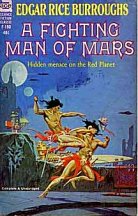
 There is nothing at all like them known on Burroughs Barsoom.
However, John Carter runs up against invisibility four times, including
psychic invisibility on Thuria and physical invisibility at Invak and with
the Skeleton Men of Jupiter
(the fourth time is actually Tan Hadron, when Phor Tak reinvents it in
Fighting
Man of Mars). So, it's not completely out to lunch.
We've also seen insect derived intelligent beings in the form of Kaldanes,
and we've seen fairly strange animals and beasts, including Kangaroo-men
in the Toonolian Marshes and Plant Men in the Valley Dor. So
these pixies may be par for the course.
There is nothing at all like them known on Burroughs Barsoom.
However, John Carter runs up against invisibility four times, including
psychic invisibility on Thuria and physical invisibility at Invak and with
the Skeleton Men of Jupiter
(the fourth time is actually Tan Hadron, when Phor Tak reinvents it in
Fighting
Man of Mars). So, it's not completely out to lunch.
We've also seen insect derived intelligent beings in the form of Kaldanes,
and we've seen fairly strange animals and beasts, including Kangaroo-men
in the Toonolian Marshes and Plant Men in the Valley Dor. So
these pixies may be par for the course.
However, if we move beyond Burroughs, we see that ‘insect winged’ beings
are frequently reported from Mars. H.G. Wells describes similar
though, less apparently human, beings on Mars in his story ‘The Crystal
Egg’ from 1897. Winged human-like beings on Mars are prominent in Gustave
LaRouge's Prisoner of Planet Mars from 1908. These Erloors also
have the power of invisibility. Winged human beings are also described
in Gayer's Adventures of Serge Myrandahl in 1908, as well as in
Graffigny and Faure's Amazing Adventures of 1889.
All told, including both Kline and Wells, human-like but non-human,
bat/insect winged intelligent beings show up at least nine times in Mars
books or stories between 1889 and 1933. Bracket's Sword
of Rhiannon adds a ninth example of a winged race. We can
assume that Kline was familiar with at least Wells' story, although honestly,
he probably owes more to Walt Disney than to Wells (and perhaps a little
bit to Tolkien, there's some syrupy 'Bearer of the Ring' shtick in there
too). Still, these sorts of creatures seem well established
on Mars. So if John Carter never encounters them on his Barsoom,
they do seem to be around.
Location,
Location, Location!
There's a frustrating scene where Jerry Morgan and Princess Junia look
at a map and describe its contents. It's worth quoting in full,
because it's the only semi-coherent description we get:
"I found a map which shows our location,"
said Junia. "We are in the midst of the Thakor Marsh. On the rim
of which is Thakkor Castle. The Raddek of Takkor is within the Empire
of Xancibar and subject to its ruler."
"Then how far are we from Raliad."
"I have computed the distance at four thousand
Jahuds," she replied.
“May I see the map," he asked.
She rose and went into her room, presently appearing
with a roll of waterproof silk, which she spread on the taboret.
"Here is our location in the center of the Marsh," she said, pointing to
a red dot on an island.
He looked at the Map more closely.
"It appears that we are about two hundred Jahuds from the Corvid canal,"
he said, "which will take us straight to Raliad.
We are four hundred Jahuds from Dukor, capital of Xancibar, and only fifty
from Castle Thakkor...."
Notice that we don't get any bearings. No reference to which
hemisphere they're in, which way is north or south, where Xancibar and
Kalsifar are in relation to each other, or where Castle Thakkor is in relation
to Dukor. We don't even know how much a Jahud is, though it
phonetically resembles Barsoom's Haad.
I suspect that this fuzziness might be deliberate on the part of Kline.
Remember that by this time, Burroughs had already written seven Barsoom
books and they were very popular. He knew he would not escape comparison
to the Barsoom books, and out of respect, or possibly to avoid the questions
of fans with too much time on their hands (like me) he chose to make his
geography deliberately vague. The last thing he wanted to do was pop Dukor
or Raliad on top of Helium or Toonol, he'd never hear the end of it.
That may or may not be the case, who knows. But from other evidence
in the books, here's the state of our knowledge of the geography of Kline's
part of Mars.
i) Xancibar and Kalsifar appear to be bordering states;
ii) Nunt borders Kalsifar, but may or may not border Xancibar.
It probably doesn't;
iii) Thakkor Marsh appears to be a very large Marsh complex,
with a minimum diameter of at least 100 Jahuds, given that the cabin is
in the middle of it somewhere and Castle Thakkor at its edge is 50 Jahuds
away;
iv) Thakkor Marsh also appears to be within Xancibar or
at its edges, and near or on the border with Kalsifar. From the map,
it may be between the two states.
v) Castle Thakkor seems to be on the other side of the Marsh from
Dukor, Harry Thorne has to fly over from Dukor over the Marsh to get to
the castle, and that's where he's waylaid;
vi) Thakkor Marsh on one side borders a line of cliffs which
may be the edges of a continental shelf, this is described a couple of
times;
v) The Ma-Gongi, or some of them, appear to be based in
those cliffs, or a part of them;
vi) Apart from Thakkor, there appear to be an assortment
of smaller marshes, small lakes and oasis in the desert. There
are some streams which feed either into canals or into Thakkor Marsh;
vii) Kalsifar appears to be mostly surrounded by desert and scrub
in its outlands;
viii) Cities are at the junctions of Canals. Raliad
is at the center of a major junction;
ix) It's probably fairly high up in latitudes, since it
gets very cold at night. Ice forms on Thakkor swamp overnight.
x) Not much else in the way of geography, in particular,
no deep valleys, craters, volcanoes or volcanic craters, giant natural
rivers, mountains or glaciers, no dead cities either, it's likely that
most of the action is taking place on a sea bed, to account for the featurelessness;
xi) Xancibar seems to be a much smaller and more compact state
than Kalsifar, given the relatively small distances involved (a maximum
of 450 Jahuds between Castle Thakkor and Dukor, in contrast to four thousand
Jahuds from their place in the swamp to Raliad. It's likely
that Kalsifar is mostly desert, while Xancibar's territories are richer.
Kalsifar is the largest most populous state on Mars, or at least, in that
region of Mars.
Ready to roll?
Thakkor Marshes
The biggest and most well defined geographical feature on Kline’s Barsoom
are the Thakkor Marshes. Given Thaine's Map, 100 jahuds diameter
is a minimum size, since it's clear that the swamp borders an extensive
range of continental shelf or cliffs.
The most obvious thought is to identify the Thakkor Marshes with the
Toonolian Marshes. But this doesn't hold up. The Thakkor
Marshes are too cold, ice forms at night, which suggests northern latitudes
(or possibly equivalent southern latitudes) closer to the pole.
The Toonolian Marshes are on the equator.
So, if not there, where? Is the Thakkor Marsh a new feature,
or can we relate it in any way to any piece of Barsoom that we know about?
In fact, there is a candidate. On Burroughs Barsoom, there is
only one other set of Marshes big enough and extensive enough that Burroughs
characters and descriptions actually make reference to it, although no
one actually went there in his books. The great salt Marshes
surrounding Gathol.
Gathol is the oldest city on Burroughs Barsoom. Originally located
on a sea-mountain island in the ocean, as the waters dried up, Gathol simply
moved down the side of the mountain. The great salt marshes
are the remnant of the sea bed.
Now, as noted in Matching
Mars, seamountains are rare on Mars. Mars history and geology
are different from Earth's, there's no moving plate tectonics, and thus
not a lot of volcanoes from plate activity. There is only one
region which would fit the description for Gathol as being an island nation
based on a seamountain, on Mars topography.
This is the Elysium volcano complex, located at approximately 150 longitude,
20 latitude on the MOLA topographic map. Let's go take a look
at it shall we.
The geography of Elysium is that we've got the principal volcano and
a couple of subsidiary volcanoes north and south of it. It slopes
off pretty steeply on the north, south and west sides, but the slope is
much more extensive and much more gradual on the east side, leading to
a 'splash of highlands.'
Now, applying this geography to Barsoom, this would give us Gatholian
Marshes on the north, south and west side of Gathol. On the
East side, Gathol would be facing rocky highland desert, the remains of
its former island hinterland, and eventually, after a few hundred miles
of rocky desert, marsh again. Gatholians probably don't travel
east much. It's just empty rocky desert leading to marsh, and
they've got marsh right next door on three sides, so why bother?
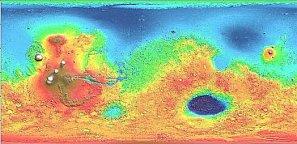
But, if you're looking at the MOLA
topographic map on the internet, it has a zoom function.
So, zoom in on the eastern edges of the green area of Elysium's splash,
where it meets the blue area of the former sea. What do we
get? Lines of cliffs. Ladies and gentlemen, we
have found Thakkor Marsh! It's the eastern part of the Gathol
Marsh complex, although given its distance, it may well qualify as its
own Marsh complex.
Circumstantial
Evidence, Birds and the Bees
Are we sure? Is there other evidence? In fact,
there are a few other pieces of circumstantial evidence which tend to support
this location for the Thakkor Marsh.
One is the Ma-Gongi. If they are related to the Okar, as
they seem to be, we know that the Okar currently inhabit the north pole
region. It stands to reason that any of their offshoots would
probably be in the northern hemisphere, at a relatively high latitude.
And its likely that their relatives would not be in the southern hemisphere.
The east side of Elysium is in the right hemisphere and while still
in temperate latitudes, is well past the equator.
The other are these goddamned giant flightless birds. Birds are
known on Mars, around forests and canals, and the Toonolian Marsh carries
quite a range of birds, even up to the giant Malagors, capable of carrying
a human being or three.
Flightless birds pose a problem. You see, the trouble is
that there's a lot of competition and a lot of predators on the ground.
Normally, that's not a problem, birds just fly away from predators and
outdistance competitors. But moving to the size where you become
flightless poses big problems for birds.
Thus on Earth, most birds who become flightless are doing so on Islands
or Island continents where there aren't any predators or the competition
isn't so savage that they'll get wiped out right away. The
best examples of this, of course, are the Moas of New Zealand and the Elephant
Birds of Madagascar (neither of which survived meeting us).
There's also the Dodo of Mauritious, the great Auks of the north sea (likewise
did not do well), the penguins of Australia, and the Phororacid predator
birds of South America when it was an island continent, and the Diatrama
predator birds of North America in the period after the dinosaurs and before
mammals got going.
Basically, they can't force their way into niches already occupied by
animals, but if those niches are empty, like on an island, then birds can
fly in, eventually give up their wings and start occupying those
niches. Birds are the only animals that can reach these islands,
thus there's no competition.
Now, looking at the topographic
map of Mars, we'll note that there's a shortage of large isolated islands
or island continents. On the mainland, which is most of Mars,
we've got geographical continuity, and several lines of life forms, including
four, six, eight and ten limbed all competing with each other.
Barsoomian birds will have no opportunity to evolve giant flightless forms
in that environment.
The only place you can possibly expect flying birds to grow into flightless
thirty or forty foot monsters on Mars is on the Elysium plateau.
In other words, on Gathol and its interland area. This explains
why Kline’s area of Barsoom features these monsters. As the
seas receded, the flightless birds of Gathol continually moved out onto
the shallow slope of the eastern highland of Elysium, the green area, adapting
to the increasingly arid conditions. As the sea bottoms dried,
they kept moving out, and managed to make this area of the Martian deserts
and Marshes their own, occupying a large pocket, likely between Olympus
Mons and Tharsis on one side, and Elysium on the other.
Thoats and Banths get the rest of the planet, as far as we can tell, but
the giant flightless birds of Elysium seem to be defending their territory
as the dominant predators.
Finally, there are the winged insectoid Ulfi. Burroughs doesn't
encounter such creatures, and so we can't locate them through him.
But Wells in ‘The Crystal Egg’ describes such creatures, as well as several
large flying insects similar to those in Swords of Mars.
And more, he describes the giant valley where his race of human-like flyers
is found. It is a roughly north/south valley bordered by high
cliff walls, in the northern hemisphere. There is in fact a
roughly north/south valley with high cliff walls in the northern hemisphere,
just between Olympus Mons and the Tharsis Montes, on the east side of the
west side of the Tharsis bulge at approximately -135 longitude and 10 degrees
latitude. Check it out.
The flyers appear to be associated with Tharsis. The two
other stories that allow us to guess at the locations of the flying races
appear to put them in the Toonolian Marshes and in volcanic caverns on
the east side of Tharsis. We theorize that this is consistent
with the insectoid flyers, as well as Kaldanes and Sarmaks, and the other
insects all evolving in an ecological ‘island’ cut off by deserts in the
shadow of the south of the Tharsis bulge.
After evolving there, the insect and flyers moved up the east and west
sides of Tharsis, and Well's ‘Crystal Egg’ finds them in a large fertile
valley stronghold on the west side, an area from which they and the insects
would move west out towards Gathol and towards the Thakkor marshes.
Finally, there's a very odd, very loose phonetic connection. The
dominant city of Xancibar is Dukor. This is phonetically similar
to Dusar and Duhor, two Barsoomian cities. We know from the
Manator trio, and Invak/Onvak that sometimes relatively close Barsoomian
cities can have phonetically related names. If you look at
our ‘Geography of Mars’ article, you'll note that Duhor is located in the
Artolian mountains, provisionally identified as the volcanoes of Tharsis,
probably between Olympus and the Tharsis Montes group (but just north of
Wells’ Valley), so that seems to fit. Dusar is in the northern
hemisphere, and appears to be placed substantially north and east of Gathol,
so it too is in the right neighborhood.
So, yellow men from the north, giant birds from the east and insects
and winged humanlike creatures from the west. The circumstantial
evidence all points to the sea bed between Elysium and Tharsis as the location
for Kline’s Barsoom.
Xancibar,
Khalsifar and Nunt
Now, we are left only with the task of trying to particularize the geography
of the three Martian nations of Xancibar, Khalsifar and Nunt.
Well, let's turn to the biggest, Khalsifar. It's territory
appears to be the largest, given the distances on Thaine's map. It
also appears to be principally desert, though it contains small marshes
and borders on the Thakkor Marsh complex. Anything else?
Yes. They're building another canal.
Okay, this is more significant than we realize. If they're
building another canal, it most likely suggests that they've got water,
or access to regions with water. Now, the sea beds are dry
desert. So, there are only two places left in the area where you
will find significant amounts of water sufficient to float a canal.
One is the polar region, and run off from the polar glaciers.
The other is the sides of the Tharsis uplift region. Tharsis
is so high, that it literally acts like a mountain range, and is a barrier
to moisture bearing clouds. The clouds pile up and corral at
the cliffs of Tharsis, eventually packing so tight that they release their
moisture as rain, or as mountain run off streams. That's why mountain
ranges can be so wet and rainy, and why they can sometimes be desert dry
on the other side.
So, this means that Khalsifar is likely in the north and the east, in
terms of the Thakkor marshes. Its territory probably borders the
northern edges of the Marshes. It probably dominates the northern
basin and the flows of water in this region, and this control of the source
of waters makes it the dominant power.
Khalsifar's neighbors in terms of Burroughs city states would be Duhor
in its west, Dusar in its East, and, most interestingly, the First Born
black principality of Kamtol, and the dead and abandoned capital city of
the white Orovars, Horz. That's particularly interesting, given
Khalsifar's racial mixture. Of course, Duhar, Dusar and
Kamtol are mostly neighbors to lots and lots of desert, most of the population
on both Kline's and Burroughs' Mars are in city states, with thinly populated
or unpopulated deserts taking up most of the space.
Xancibar we know borders on Khalsifar and includes the Marshes.
This puts it to the west of Gathol. Though probably south of Burroughs'
Dusar. It is probably to the south and west of Khalsifar.
It's probably closest to Gathol in terms of Burroughs cities, but likely,
a vast stretch of particularly barren and inhospitable rocky desert, Gathol's
eastern hinterland, acts as a barrier between them.
This leaves only Nunt, for which we have almost no geographical location.
The evidence would suggest that it is to the south of Khalsifar and to
the east of Xancibar, and more than that, we cannot say.
As final note, this picture also explains why we don't see the Green
Martians in or around the deserts of Xancibar and Khalsifar.
Look at the geography again. Tharsis is a huge elevated highland,
probably uninhabited and uninhabitable, it's a barrier. Elysium
is an island, and so uninhabited by Green Men. The only place
that the Green men could come from would be the mainland to the south.
Which means that they'd be heading to Nunt. So Nunt is probably
the barrier to the Green Men moving north into Xancibar and Khalsifar.
And in fact, there are definitely Green Men. Linking back
up to Burroughs geography, the area in the southern hemisphere directly
south of Nunt are the lands of the Thark and Warhoon! Luckily,
the Thark and Warhoon are widely distributed and organized mostly as raiding
parties, so they aren't likely to overrun Nunt with their superior firearms
any time soon. A mass horde attack like the sack of Zodanga
is, by all accounts, quite rare. The combination of Thark and
Warhoon raiding Zodanga is unique, and its likely that a major movement
of Thark or Warhoon separately against Nunt, would simply leave one tribe
vulnerable to attack by the other.
In the meantime, the presence of the Thark and Warhoon nations in the
south means that Kline’s area of Mars is inaccessible from that direction
to the Red nations of Barsoom. Throw in the geographical barriers
of Tharsis in the east, and the sterile Gathol tableland desert and Thakkor
marshes in the west, and we see that Kline’s Mars is isolated from mainstream
Barsoomian society on three sides. This might well account
for the ethnic and linguistic discrepancies. This is literally an
isolated corner of Barsoom.
The closest Barsoomian societies would be Duhor, tucked into the Artolian
mountains on the east, in the Tharsis region, and probably bordering on
Nunt, and Dusar, in the northwest, probably bordering on Khalsifar.
From the point of view of Helium, they probably don't have a clue that
these lands even exist.
Consider that the closest neighbor to this region is Zodanga, formerly
Helium's bitter arch rival. In order for explorers from Helium
to gain knowledge of this region, they would have to cut through Zodanga,
cut through Thark and Warhoon and come up from the south to Nunt.
Or they'd have to go north to Gathol, and then go through marshes and desert
to Xancibar. Or they'd have to go even farther north, cut around
east, skirting the edges of the Gatholian Marshes, go through Dusar and
finally reach Khalsifar's deserts and eventually Khalsifar... A journey
pretty much equivalent to going to the other side of the planet.
In short, its pretty likely that Helium either had no information at all
on the region, or it was extremely sketchy and generic.
In fact, looking at various Burroughs and Barsoom maps, it becomes clear
that the likely area of Kline’s Mars shows up as a big empty space.
Given that most of John Carter's geographical and social information came
from Helium, it is perhaps, not surprising that the region was unknown,
and perhaps not unexpected that it might diverge racially and socially
from the norms that Carter expected.
This leaves only Kline’s possibly apocryphal lost works, Meteor Men
of Mars and Hunters of Mars. But since we don't have those, since
there are barely even references to those, we can't say anything.
Overall, it seems eminently feasible to locate Kline’s Mars, both
within the geography of the real Mars, and within the geography of Barsoom
as applied to the real Mars. It is arguably complementary to
what we can construct of the geography of other writers slices of Mars,
including Wells, Gulliver Jones, LeRouge and Gayer. And
most pleasingly, we can make it work in various ways, including Barsoomian
ethnography, species distribution, geography, phonetics and politics.
Otis Kline’s Mars and Edgar Rice Burroughs' Barsoom fit well together,
like pieces of a puzzle. I think that Kline would have been
pleased.
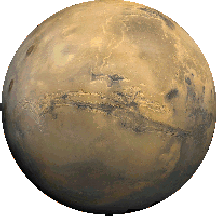 . . .. . .
. . .. . . 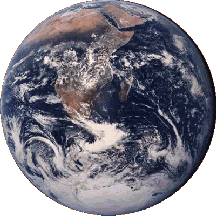
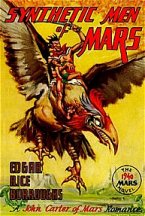
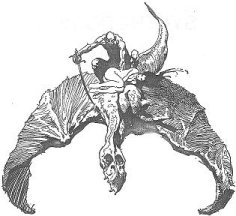
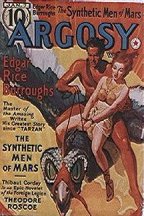
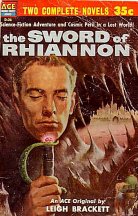
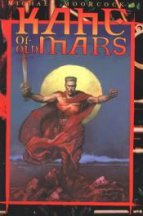

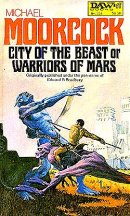
![]()

![]()